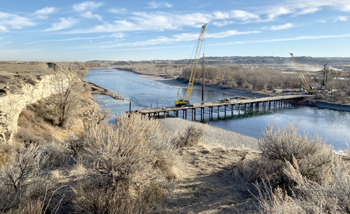Construction Begins on Bypass Bridge over Yellowstone River
By Evelyn Pyburn
Construction of the bridge across the Yellowstone River, as part of the Billings Bypass, has begun. Workers and heavy equipment are coming and going across a temporary work bridge, as they install the pilings that will support what will be a bridge large enough to eventually accommodate a 4-lane road and a ten-foot mixed use path, which will be part of a system to connect the Heights and Johnson Lane in Lockwood.
“They are driving the bridge pilings in the winter when the river is the lowest,” explained Lisa Olmsted, the Public Involvement Manager for DOWL, the engineering firm on the project. The work will continue throughout the winter. With the pilings in place, “they will be ready to hit the ground running in the spring,” said Olmsted, explaining that the contractor, Wadsworth Brothers Construction, plan to predominantly complete the bridge project in 2021. Though the roadway will be built as two-lane, the bridge is being built with four lanes to accommodate future growth.
The Yellowstone River Bridge project segment is the second portion of the six-phase project and is anticipated to cost $30.1 million. The construction of Five Mile Road, the first phase, was completed this past summer. The third phase, construction of the Johnson Lane Interchange will begin in 2021, which will be of a diverging diamond interchange design, the first of its kind in Montana, though they’ve been well-received in other states.
Building a new bridge across the Yellowstone River is a rather rare event. It’s been about a hundred years since a new bridge was built across the Yellowstone, although there have been quite a few bridges rebuilt, according to Rod Nelson, Montana Department of Transportation Billings District Administrator.
According to Nelson, during the time in which he served as construction project manager for the district, (1990 to 2003), “We replaced four different bridges over the Yellowstone. One at Pompeys Pillar, one south of Laurel, one at Reed Point, and the east bridge in Billings. All of these bridges were previously old steel truss bridges that were originally built around the turn of the century (late 1800s to early 1900s).”
The I-90 bridges that cross the Yellowstone River near Lockwood are the next bridges scheduled to be rebuilt, with a tentative construction date of next year, said Nelson.
Construction of the Bypass bridge is being done in close coordination with Yellowstone River Parks Association (YRPA) which manages John H. Dover Memorial Park, through which the Bypass must be constructed. Olmsted said that the Bypass will build a tunnel to access between the north and south sides of Dover Park and access from the mixed use path on the bridge to the park trail system which will open up access to the park. She said that YRPA officials are excited about the potential that the project holds for the future of Dover Park.
The other phases of the Bypass include two sections between the bridge and the Johnson Lane Interchange which will include an overpass of Coulson Road and the railroad tracks, and the last phase will be the construction of a two-lane road that will parallel Mary Street, connecting the bridge to Main Street in the Heights. The Bypass is expected to be completed by 2025, but the schedule is dependent throughout the process on funding availability and construction schedules.
Despite the project name this is not a bypass, reminds Olmsted. The new street will be an urban arterial similar to Rimrock Road. The new roadway will have a different name .
A webcam showing progress on the bridge and additional project information are available on the website: https:// www.mdt.mt.gov/ pubinvolve/billingsbypass.


0 comments